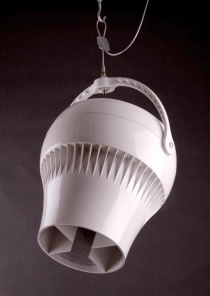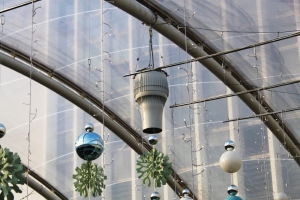Destratification drives down energy use and costs

Heat at high level in most buildings is wasted heat, and getting it back to where the people are can be extremely cost effective. Stephen Bridges of Airius takes up the story.
Often described as the missing piece to the HVAC puzzle, thermal destratification, the recycling of rising hot air and sinking cool air, is simple, effective and remarkably economical.
Contrary to popular perception, destratification is not the preserve of big spaces. Even if your ceiling is as low as 2.5 m, you can benefit from destratification fans that are really no more complicated to install than a light fitting. The systems are for use in virtually any space, with ceiling heights ranging from a normal office to a high-bay warehouse. The same simplicity applies even to a 38 m-high aircraft hangar!
Most of us live and work in a space within 2 m from the floor, so any space above that is potentially a heat sink. The natural process of thermal stratification occurs in all buildings and is caused by warm air rising up to the ceiling or roof space because it is lighter than the surrounding cooler air. In contrast, cool air falls to the floor as it is heavier than the surrounding warmer air, creating hot and cold spots and proving difficult to circulate, resulting in dramatic differences in temperature from floor to ceiling.
 |
| The Airius unit for thermal destratification is designed to continuously move a column of air to the floor. |
Destratification systems offer substantial annual energy savings on both heating and cooling costs to reduce consumption by up to 50%. This is achieved by the technology working to equalise the air temperature within internal spaces. The greater the temperature differential, the greater the saving on heating and cooling costs, as well as energy consumption. The higher the ceiling, the greater the heat gradient and potential heat loss, but nevertheless, the principle applies in any space — namely to recycle and re-use the heat that rises and cooled air that sinks, becoming trapped and uncirculated, and the savings are going to be immediate.
Maximising the performance of existing heating and cooling systems and equipment, destratification systems are designed to be installed alongside all types of heating and cooling equipment to optimise the hot or cool air produced — to create uniform temperatures.
HVAC systems typically over-deliver on heating or cooling to compensate for stratification and attempt to achieve the required temperature at working level (this is normally only around 1.5 to 2 m from the floor). This costs a considerable amount of money and produces significant carbon dioxide emissions.
Large amounts of wasted heat can build up below in ceilings where the difference in temperature can easily be 14 K or more than the temperature at floor level, depending on the floor to ceiling height. Conversely cooled air falls. It becomes trapped and proves difficult to circulate fully, escaping out of open doors, windows etc., causing hot and cold spots.
Destratification systems are most commonly installed in supermarkets, warehouse and distribution centres, schools, sports halls, defence and government facilities, museums, gyms, manufacturing facilities, shopping centres and theatres. Even buildings without heating or cooling can benefit from fresher environments. Destratification fans improve air change rate efficiency and indoor air quality , providing a natural cooling effect of moving air during the summer, as well as recirculating heat emitted from lighting, machinery, office equipment and body heat during winter months.
A typical installation includes a series of fan units, evenly spaced throughout a facility. The goal is to equalise the temperature throughout the space, minimising convective heat loss from the working area — in other words, to destratify the air space. The way to do this turns out to be remarkably simple, involving no complex programming of a building energy management system, no need for extra air-conditioning inspection units that need regular statutory inspections, or ductwork that will need cleaning and exhausting.
 |
| Thermal destratification finds application in retail environments. This is the John Lewis store in London’s Oxford Street. |
According to utility giant DTE Energy in the USA, thermal stratification is the single biggest waste of energy in buildings today, and The Carbon Trust recommends destratification as one of its top-three carbon-saving measures.
So who is using this technology and is it working for them?
Lush Cosmetics reported a return on investment of 26 days at its Poole factory.
Impress Metal Manufacturing made a £62 251 saving on its heating costs the first winter after an Airius system was installed.
Morrisons supermarkets turned to us to resolve the problem of having too-chilly food aisles alongside too-warm household aisles.
At the Genentech temperature-controlled pharmaceutical warehouse in Louisville, Kentucky, a major commercial disaster was averted after the US Food & Drug Administration found the higher warehouse bays were too warm to be fit for purpose. Airius destratification fans resolved these issues within days.
Stephen Bridges is managing director of Airius.







